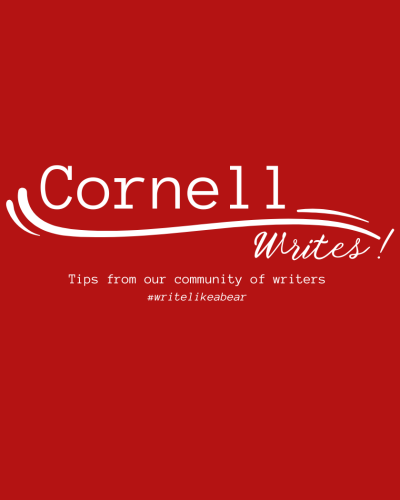Cornell Writes! Tips from our community of writers is a digital newsletter sponsored by the Knight Institute for Writing in the Disciplines and the Cornell University Graduate School.
Each week, a member of our writing community – a Graduate Writing Service, English Language Support Office, or Cornell Writing Centers tutor; a writing specialist from the Knight Institute; a writing instructor from our First-Year Writing Seminars or Writing in the Majors programs; maybe YOU – shares a writing strategy from their own writer’s toolkit. #writelikeabear
Contact Tracy Hamler Carrick with questions and ideas.
Meet Kate Navickas
Hello Cornell Writers! My name is Kate Navickas. I teach writing and direct the Cornell Writing Centers. And, I am always writing something–example analysis paragraphs to use with students in class, writing center social media posts or promotional website articles, and even the occasional journal article or conference paper.
Here is this week’s Writing Tip!
Reverse outlining is a strategy for both reading and writing. Essentially, you create an outline of a text that already exists, whether that text is a draft you or someone else has written.
In reverse outlining, you ask what is the writer doing and saying in each paragraph. If the text is longer, you may just want to ask what is the writer doing and saying in each section.
When you apply this to your own draft, reverse outlining will allow you to see how your essay is organized and any potential gaps in thinking, logic, or connection back to your larger focus.
When you use reverse outlining to help you better understand a text that you are reading, it can help you gain a broader perspective of how a whole text works and deepen your reading comprehension.
Reverse Outlining for Self-Assessment or Peer Review
STEP 1 | SUMMARY STATEMENT
Write out the argument of the whole essay/article/paper in 1-2 sentences. In 2-4 additional sentences, identify the purpose of the work and the intended audience.
STEP 2 | REVERSE OUTLINE
For each paragraph, in the margins of the essay/article/paper, write 1 sentence that captures the point of the paragraph. Here are a few templates:
- In this paragraph, the writer presents/summaries/analyzes/synthesizes/ X (argument, claim, idea) in order to Y.
- In this paragraph, the writer reviews X aspect (findings, methods, overview) of Y scholar’s(s’) work in order to show M.
- In this paragraph, the writer compiles X (data, theories, concepts) in order to agree with/extend/refute Y.
STEP 3 | Compare the REVERSE OUTLINE and the SUMMARY STATEMENT
Consider the following questions:
- How well does the writer articulate and support the argument?
- Is the essay/article/paper focused enough to be useful for the argument?
- Does the writer clearly name and explain the purpose of the writing project?
- Does the writer identify sources, disciplinary areas, and disciplines that they are working with clearly enough so that another reader can understand the writing goals and argument?
Reverse Outlining for Reading
STEP 1 | SUMMARY STATEMENT
Write out the argument of the whole essay/article/paper in 1-2 sentences. In 2-4 additional sentences, identify the purpose of the work and the intended audience.
STEP 2 | REVERSE OUTLINE
For each paragraph, in the margins of the essay/article/paper, write 1 sentence that captures the point of the paragraph. Here are a few templates:
- In this paragraph, the writer presents/summaries/analyzes/synthesizes/ X (argument, claim, idea) in order to Y.
- In this paragraph, the writer reviews X aspect (findings, methods, overview) of Y scholar’s(s’) work in order to show M.
- In this paragraph, the writer compiles X (data, theories, concepts) in order to agree with/extend/refute Y.
STEP 3 | Compare the REVERSE OUTLINE with the SUMMARY STATEMENT
Consider the following questions:
- How well does your SUMMARY STATEMENT capture the argument of the essay/article/paper?
- How might you revise and expand the SUMMARY STATEMENT to more effectively document the work of the essay/article/paper?
- What have learning about yourself as a reader? How might you read differently next time?



